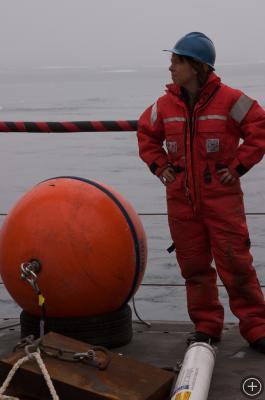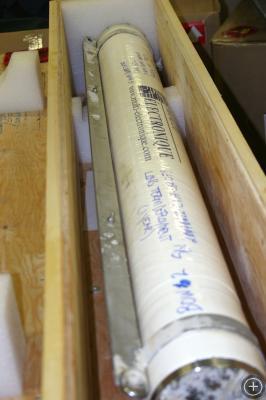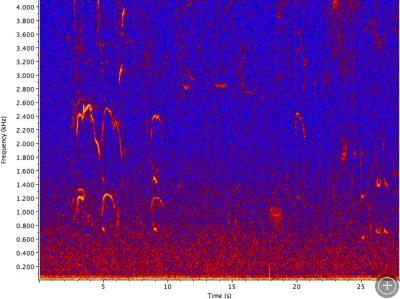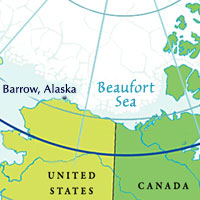Ears of the Deep: Hydrophone Arrays
ABOARD THE USCGC HEALY, ON THE BEAUFORT SEA– While much of the Coast Guard personnel continued to host the distinguished visitors, the science work increased in tempo. The primary science activity to be accomplished on the cruise is to recover and deploy moorings.
Moorings can be used for a variety of purposes, but for this cruise moorings are being used to keep acoustic and oceanographic sensors in place for some period of time (typically a year). Scientist Kate Stafford from the University of Washington’s Applied Physics Lab (APL) has a set of acoustic sensors forming a ‘hydrophone array’ that are to be recovered and (re) deployed later in the cruise.
Hydrophones are passive measuring devices– they do not emit any sound themselves, but instead convert acoustical energy in the water to an electrical signal. Kate analyzes the sounds or “vocalizations” of whales, bowhead and beluga whales in particular, using these instruments. Fixing a hydrophone array in place underwater for a relatively long period of time (a year) allows scientists to listen for the presence of cetaceans (whales, dolphins, and porpoises) from multiple locations, even in poor weather conditions.
Detection Using Passive Hydrophone Arrays
Each hydrophone Kate uses sits inside an instrument that includes the hydrophone itself, a data recorder where the digitized audio samples are stored for later retrieval, and a pack of batteries to keep the whole instrument running for a year or more. These are the instruments that are attached to moorings that are deployed out at sea until they are recovered. When these types of instruments are placed sufficiently close together, more than one will pick up the same vocalizations or sound. When this happens it may be possible to locate and track a particular sound source (animal or otherwise) over time. When the instruments are used together in this way, they behave as an array, or group that is acting together cooperatively. Hydrophone arrays can also be used in estimating animal populations, although gaining high confidence using this approach is an ongoing challenge.
When the data from Kate’s instruments is recovered, it can be processed in a number of ways. One way is to simply listen to the sounds on the recordings. A person with enough expertise in doing this can pick out some of the vocalizations and other sounds. As an example, you can listen to the recording of a beluga:
Beluga Whale Recording
A more quantitative approach involves taking the data and analyzing the frequency, timing and intensity (loudness) of particular sounds. A popular way of doing this is to visualize this information on a special kind of graph called a spectrogram. In this spectrogram of a beluga vocalization in the Beaufort sea, for example, the intensity of sound at a particular frequency at a particular time is indicated by the color (blue less intense; red most intense).
By looking at the spectrogram or other types of graphs (or by using a computer program to do so), acoustic frequency patterns resulting from cetacean vocalizations (or boats, or the sounds of airguns used in seismic exploration, etc.) can be found.
For the interested reader, the analysis of hydrophone data is similar to both signal processing and image processing techniques. Common techniques include matched filters, band-limited energy summation and classification, image matching techniques on the spectrogram or time series, and other frequency-domain analysis techniques such as wavelet-based decomposition. A more detailed explanation of how this can be accomplished and why fixed passive arrays are useful for monitoring cetaceans is given in this paper.
The ultimate goal for much of the related science here is to estimate animal populations, which is important for both ecological understanding and policy-setting reasons. As suggested above, there are a number of factors posing challenges to doing this effectively using acoustic arrays. Animals may use different vocalizations at different points in time and these may vary in many ways (e.g., frequency, phase, amplitude, modulation, etc) based on its activity (e.g., feeding or seeking a mate). In addition, instruments are only capable of detecting a signal up to some distance (which depends on frequency), so forms of statistical inference must be employed in an attempt to estimate a population given a number of detections.
Necessarily, these are only estimates, but they are estimates based on measured data, and moored acoustic arrays offer some significant advantages for making such measurements versus the alternatives of visual observation from ships (or other platforms like airplanes, etc) or from towed hydrophones that only last a few days or weeks. Moorings last a long time and are relatively immune to poor weather so they can offer a richer data set on which to base estimates. Of course, they need to be designed, deployed, and recovered, which generally involves a ship such as HEALY…

 No comments
No comments 










